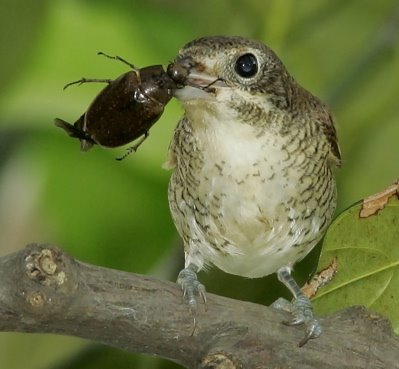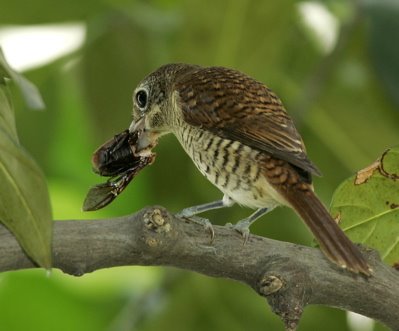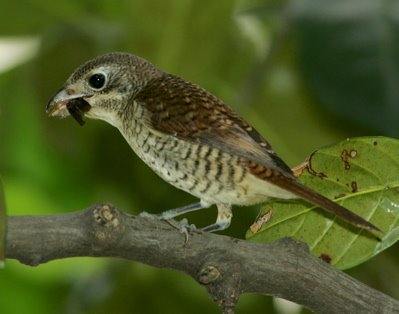How the Tiger Shrike dismantled a beetle
Shrikes are songbirds. But when they hunt they behave like little raptors. An earlier posting showed how aggressive a juvenile Tiger Shrike (Lanius tigrinus) was when eyeing the white-eyes in a cage. Given a chance we are sure it would have devoured one of the caged birds.
 The diet of these shrikes consists of large insects and small vertebrates that include songbirds, reptiles, rodents and even mammals. So far there has not been any local report of a shrike capturing a vertebrate prey. But in mid-September 2006 we observed a juvenile Tiger Shrike manipulating a large scarab beetle (above).
The diet of these shrikes consists of large insects and small vertebrates that include songbirds, reptiles, rodents and even mammals. So far there has not been any local report of a shrike capturing a vertebrate prey. But in mid-September 2006 we observed a juvenile Tiger Shrike manipulating a large scarab beetle (above).  The juvenile bird was on a perch, looking handsome and posing for the camera. But it was actually eyeing the surroundings. Suddenly it dived towards the ground and caught hold of a scarab beetle by one of its legs (above).
The juvenile bird was on a perch, looking handsome and posing for the camera. But it was actually eyeing the surroundings. Suddenly it dived towards the ground and caught hold of a scarab beetle by one of its legs (above).  Returning to its perch and with one of its feet holding down the beetle, it started to stab the wriggling insect with its sharp beak. Then, holding on to the head (above), it thrashed it against the branch until it managed to tear away the upper portion from the body and got a first taste of its crunchy meal (below).
Returning to its perch and with one of its feet holding down the beetle, it started to stab the wriggling insect with its sharp beak. Then, holding on to the head (above), it thrashed it against the branch until it managed to tear away the upper portion from the body and got a first taste of its crunchy meal (below). 
 Beetles have a thick protective sheath, the elytra, over the back portion of the body. This is made up of the hardened forewings, tucked under which is the pair of functioning membranous wings. The other parts of the body have a covering of thick cuticle. So beetles are generally well protected from predators. But not from shrikes!
Beetles have a thick protective sheath, the elytra, over the back portion of the body. This is made up of the hardened forewings, tucked under which is the pair of functioning membranous wings. The other parts of the body have a covering of thick cuticle. So beetles are generally well protected from predators. But not from shrikes!  The shrike next tried to crush the headless beetle with its powerful beak (above). But the beetle's elytra proved too hard. With another swift swing it got the elytra detached. The bird then tried to squeeze out the soft tissue and in the process nearly lost its grip on the perch.
The shrike next tried to crush the headless beetle with its powerful beak (above). But the beetle's elytra proved too hard. With another swift swing it got the elytra detached. The bird then tried to squeeze out the soft tissue and in the process nearly lost its grip on the perch.  It continued to crush the thorax with its powerful jaws, pulling at the soft tissues, determined to get to the succulent part. At this point the beetle thorax was totally mangled (above).
It continued to crush the thorax with its powerful jaws, pulling at the soft tissues, determined to get to the succulent part. At this point the beetle thorax was totally mangled (above).  Swallowing the thoracic portion, it tried to swallow the remaining part but could not succeed (above). It was either too hard or too big. It tried to crush and flatten it further in between its mandibles before finally finishing its meal (below).
Swallowing the thoracic portion, it tried to swallow the remaining part but could not succeed (above). It was either too hard or too big. It tried to crush and flatten it further in between its mandibles before finally finishing its meal (below). 
Tha above account is by Melinda Chan. All images by Chan Yoke Meng. The beetle was identified with the help of Dr Cheong Loong Fah
Labels: Feeding



3 Comments:
How big was the scarab?
According to Melinda, the length of the beetle is approx 4cm.
Greetings I was captivated by your site. Keep up all your hard work.
Post a Comment
<< Home